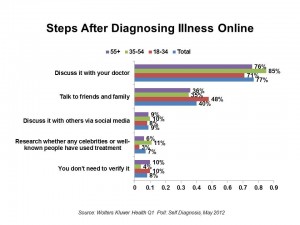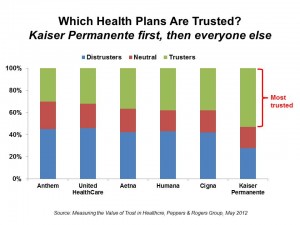
Trust is a precursor to health engagement. Trust impacts health outcomes such as a patient’s willingness to follow a doctor’s or health plan’s instructions. Two new studies point out that U.S. consumers don’t trust every touchpoint in the health system. Online medical information has become a trusted channel. Health plans? Not so much.
Wolters Kluwer’s Health Q1 Poll on Self-Diagnosis found that consumers trust online health information to inform themselves — even for self-diagnosis. 57% of U.S. adults turn to the Internet to find answers to medical information; 25% “never” do, and 18% rarely do. Two-thirds of people say they trust the information they find: 70% of health information seekers with college and advanced degrees trust medical information on the Internet.
Among health information seekers online, 63% say they’ve “never” had a misdiagnosis.
Furthermore, 67% of health information seekers believe that access to this information makes them better informed patients.
Underlying peoples’ search for health information online are barriers to patient-physician communication. In a 2011 poll among physicians from Wolters Kluwer, Overwhelmingly the number one barrier that physicians identify is lack of time, cited by 78% of physicians. Over one-half of physicians, though, believe that patients are misinformed. Nearly one-half believe that doctors have information overload, also compromising doctor-patient communication. Still, only 12% of physicians believe that patient access to online medical information has impeded the quality of care they provide, and two-thirds have changed an initial diagnosis due to new information accessed online.
The first chart illustrates what consumers do once they access health information online. First, most discuss the information with their doctors, across all age groups. Second, health information seekers discuss the information they find with family and friends, more commonly done by younger patients age 18-34. Social media is still a limited channel for most patients, about 9% of whom discuss self-diagnoses via social media.
 Thus, online health information is trusted, even for self-diagnosis. But health insurance plans should be envious of online health information’s position on the trust league table, because about 50% of consumers do not trust their health insurer, according to Peppers & Rogers Group’s report, Measuring the Value of Trust in Healthcare.
Thus, online health information is trusted, even for self-diagnosis. But health insurance plans should be envious of online health information’s position on the trust league table, because about 50% of consumers do not trust their health insurer, according to Peppers & Rogers Group’s report, Measuring the Value of Trust in Healthcare.
The majority of health insurers’ customers do not trust their health plans: only 43% of health plan enrollees trust their plans, while 38% distrust them and 19% are neutral. However, other health ecosystem players are trusted, such as the patient’s physician and pharmacist, with 46% and 43% greater trust, according to Peppers & Rogers’ survey data. “Thus, distrusters are not simply malcontents,” P&R writes: “they distinctly distrust their health insurer.”
The second chart presents P&R’s survey data comparing consumers’ perceptions on trust of health plans. By far, the #1 trusted plan is Kaiser Permanente. But even for mighty K-P, there are nearly 50% neutral or distrusting: fewer than for the national plans, but still very challenging.
P&R suggests four “essentials” for health insurers to create consumer trust:
- Know me, integrating consumer insights with health support for behavior change and sustainment.
- Show me that you know me, by customizing personal interactions.
- Engage me, creating reasons for consumers to have meaningful dialogue with health plans.
- Be transparent, providing opportunities for rating and commenting on services, feedback to the plan, and demonstrating openness with consumers.
In the emerging healthcareDIY era, marked by consumer-directed health plans, health insurance exchanges, and a growing roster of online and mobile tools for consumers to track and treat their own health at home and on-the-go, trust will be a key currency for business viability. These two studies demonstrate where consumers are finding trust — and identify the opportunity for health plans to break away from the pack if they engage patients transparently, supportively, and personally.




 Thank you, Jared Johnson, for including me on the list of the
Thank you, Jared Johnson, for including me on the list of the  I am so grateful to Tom Lawry for asking me to pen the foreword for his book, Health Care Nation,
I am so grateful to Tom Lawry for asking me to pen the foreword for his book, Health Care Nation,  Thanks to Feedspot for naming this blog, Health Populi, as a
Thanks to Feedspot for naming this blog, Health Populi, as a